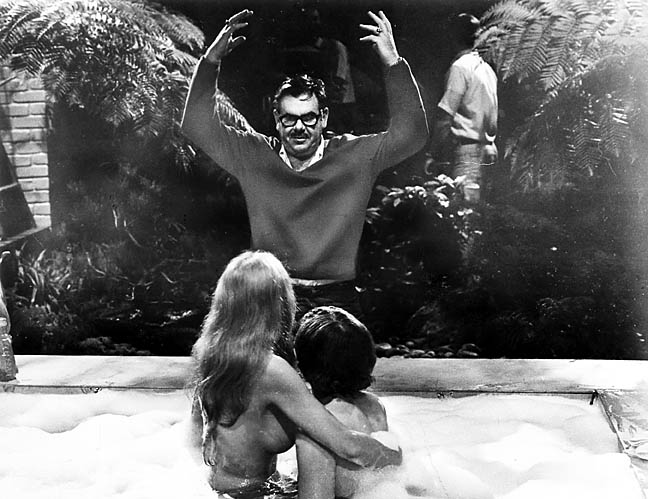Russ Meyer is dead. The legendary independent director, who made exploitation films but was honored as an auteur, died Saturday at his home in the Hollywood Hills. He was 82, and had been suffering from dementia. The immediate cause of death was pneumonia, said Janice Cowart, a friend who supervised his care during his last years. She announced his death Tuesday.
Such bare facts hardly capture the zest of a colorful man who became a Hollywood icon. Meyer’s “The Immoral Mr. Teas” (1959), hailed by the highbrow critic Leslie Fiedler as the funniest comedy of the year, created the skin flick genre, and after the box office success of his “Vixen” (1968) he was crowned “King of the Nudies” in a front-page profile in the Wall Street Journal. His “Beyond the Valley of the Dolls” (1970), for which I wrote the screenplay, represented the first foray into sexploitation by a major studio (20th Century Fox).
His films were X-rated but not pornographic. Meyer told me he had two reasons for avoiding hard-core: (1) “I want to play in regular theaters and keep the profits, instead of playing in porn theaters and doing business with the mob.” (2) “Frankly, what goes on below the waist is visually not that entertaining.” For Meyer, what went on above the waist was a lifelong fascination; he cheerfully affirmed his obsession with big breasts.
Meyer was the ultimate auteur. He not only directed his films, but could and often did write, photograph, edit and distribute them, and carried his own camera. In a genre known for sleazy sets and murky photography, Meyer’s films were often shot outdoors in scenic desert and mountain locations, and his images were bright and crisp. He said his inspiration was Al Capp’s “L’il Abner” comic strip, and his films were not erotic so much as funny, combining slapstick and parody. He once told me there was no such thing as a sex scene that couldn’t be improved by cutaways to Demolition Derby or rocket launches.
Meyer was born March 21, 1922 in San Leandro, Ca., and raised in the Oakland area by a mother who gave him his first 8-mm movie camera. He enlisted at 18 in the U. S. Army Signal Corps, learned motion picture photography in an Army school at MGM, and found World War II “the greatest experience of my life.”
He was often assigned to Gen. George Patton, and told of being taken along one night late in the war, to shoot the newsreel footage when Patton assembled a strike force to dart across the lines and capture Hitler – who was believed to be visiting the front. The report was false, Hitler was not captured, Patton issued dire warnings to anyone who spoke of the raid, and Meyer was denied the greatest newsreel scoop in history.
On another assignment, he filmed the original Dirty Dozen before they were parachuted into France, and E. M. Nathanson’s best-selling novel credits Meyer as its source. “In the real story,” Meyer said, “they disappeared and were never heard of again.”
In peacetime Meyer and other Signal Corps cameramen found themselves frozen out of the cinematographer’s union. He made industrial and educational films, and then drifted into cheesecake. More than half of the first year’s Playboy Playmates were photographed by Meyer. Observing Hugh Hefner’s success at retailing nude images of young, wholesome-looking women, Meyer tried the same approach in “Mr. Teas.” Films exploiting nudity had been consigned to marginal theaters and burlesque houses, but “Teas” won mainstream distribution, played for a year in some of its first engagements, and defined the rest of Meyer’s career.
He made one film after another, all of them involving unlikely plots, incongruous settings and abundantly voluptuous actresses. “Where do you find those women?” I asked him. “After they reach a certain bra size,” he said, “they find me.” He disapproved of silicone implants: “They miss the whole point.”
Meyer’s titles were entertaining in themselves: “Faster Pussycat! Kill! Kill!” and “Mud Honey,” both made in 1965, were taken as names by 1990s rock bands, and director John Waters said “Pussycat” was the greatest film of all time. Other directors who praised his work included Jonathan Demme, who always uses Meyer’s favorite actor Charles Napier in his movies, and John Landis. Mike Myers used music and dialog from “Beyond the Valley of the Dolls” in his “Austin Powers” pictures.
Other titles included “Motor Psycho” (1965-a busy year), “Common Law Cabin” and “Good Morning…and Goodbye!” (both 1967), “Finders Keepers, Lovers Weepers!” (1968), “Vixen” (1968), “Cherry, Harry and Raquel” (1970), “Blacksnake” (1973), “Supervixens” (1975), “Up!” (1976), and “Beneath the Valley of the Ultra-Vixens” (1979), which I co-wrote. In the 1980s he announced an epic film to be called “The Breast of Russ Meyer,” but it was never completed. He did publish a massive three-volume, 17-pound, 1210-page, $199 autobiography, A Clean Breast (2000). “It keeps you turning the pages even when you can’t lift the book,” wrote Time magazine film critic Richard Corliss, who called “Beyond the Valley of the Dolls” one of the 10 best films of the 1970s.
After I wrote a letter to the Wall Street Journal praising Meyer’s work we met and became friends, and when he was summoned by Fox to make “Beyond the Valley of the Dolls” he asked me to write the screenplay. We produced it in six weeks, making it up as we went along, laughing aloud, although in directing it Meyer urged the actors to perform with complete seriousness. The film cost $900,000, grossed $40 million, and became a cult favorite; the Sex Pistols punk rock band saw it in London in the late 1970s and hired Meyer to direct and me to write a film for them. “Who Killed Bambi?” (1978) shot for only one day before the Pistols’ production company went bankrupt.
Russ Meyer made X-rated movies, but he was not a dirty old man. He didn’t use the casting couch, prohibited sex on his sets (“save it for the camera”), and was a serial monogamist. He married Eve Meyer in 1955, and later photographed her as a Playmate; they had a friendly divorce in 1970 and continued to work together until her death in an airplane crash. His 1970 marriage to starlet Edy Williams was not so happy, and inspired a scene in “Supervixens” where the hero’s wife attacks his pickup with an axe. In later years his most frequent companion was Kitten Natividad, who starred in “Ultra-Vixens.”
He was a loyal friend. He stayed in lifelong contact with his Signal Corps comrades, organizing local and national reunions and sending tickets to those who needed them. He worked with the same crew members again and again. In a field known for devaluing women, he treated the actresses in his movies with affection and respect. Haji, Uschi Digard, Tura Satana, Kitten Natividad and the “BVD” stars Dolly Read, Cynthia Myers, Marcia McBroom and Erica Gavin stayed in contact and attended reunions.
His films were unique in that the women were always the strong characters, and men were the mindless sex objects. The film critic B. Ruby Rich called him “the first feminist American director.” Meyer took praise with a grain of salt. After “The Seven Minutes” (1971), an attempt at a serious mainstream big studio picture, flopped at the box office, he told me: “I made the mistake of reading my reviews. What the public wants are big laughs and big tits and lots of ‘em. Lucky for me that’s what I like, too.”












